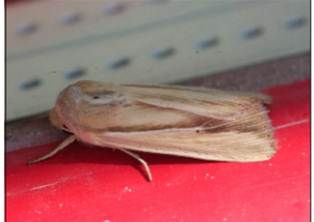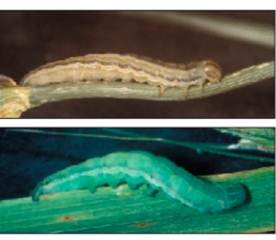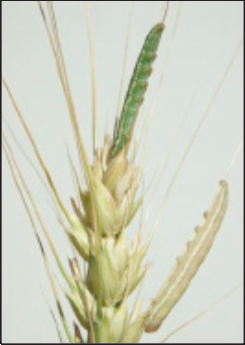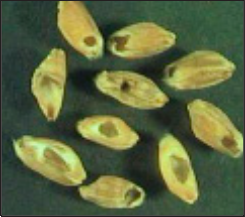Faronta diffusa (Walker)
The wheat head armyworm is a minor pest of wheat in most years but occasionally can cause noticeable crop injury. Unfortunately, the first indication of a wheat head armyworm problem is often when wheat is downgraded at harvest because of insect damaged kernels, or when larvae are noticed on grain screens at elevators. Infestations are usually too sporadic and isolated to justify any type of scouting or treatment program.
Identification / Life Cycle
The adult moth is yellowish brown with a chocolate colored stripe down the length of each forewing (Figute 7.28). The larvae vary in coloration from greenish to cream colored, depending on the maturity of the grain they have consumed, but all have longitudinal white and brown lines down each side of the body (Figute 7.29). The larvae will grow to about one inch in length and are slightly tapered to the rear end. Larvae feed on the wheat heads from evening to early morning, typically hanging onto the awns upside down and hollowing out kernels. They rest in the soil at the base of the plant during the day.
The insect passes the winter as a pupa in the soil, emerging as an adult in the spring to lay eggs on a wide variety of grasses, although wheat is highly preferred. Unlike the true armyworm, there is more than one generation per year, but it is the first generation of larvae that feeds on maturing wheat heads and causes direct damage to kernels (Figure 7.30). Second generation moths emerge over an extended period in summer months and lay eggs on warm season grasses. Fall flights can be observed well into October, and it is not clear if a portion of these represent a third generation, late-developing second generation individuals, or some combination of both. Larvae that complete feeding on maturing warm season grasses in the fall pupate in the ground but remain dormant until the following spring.
Figure 7.28 Adult wheat head armyworm moth.

Figure 7.29 Wheat head armyworm larvae.

Figure 7.30 Wheat head armyworm larvae feeding on a maturing wheat head.

Figure 7.31 Damaged kernels due to wheat head armyworm feeding.

